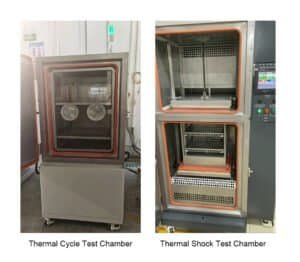Thermal testing is an essential component of product development, particularly in fields like electronics and materials engineering, where exposure to high temperatures can significantly impact product performance and lifespan. Two common thermal testing methods are thermal cycle testing and thermal shock testing. While they share some similarities, there are significant differences between these two techniques.
Thermal cycle testing involves subjecting a sample to a series of repeated heating and cooling cycles. The sample is typically placed in a temperature chamber, which can be programmed to control the temperature range, heating and cooling rates, and the number of cycles. During the test, the sample’s performance is monitored to observe changes in its properties over time. The goal of this testing method is to evaluate the durability of a material or product under extreme temperature conditions, such as those encountered during use or transportation.
On the other hand, thermal shock testing involves subjecting a sample to a rapid and extreme temperature change. Unlike thermal cycle testing, which involves gradual changes in temperature, thermal shock testing involves exposing the sample to a sudden temperature change, usually from one extreme to another. This rapid change creates thermal stress within the sample, which can cause cracking, warping, or other forms of physical damage. The goal of this testing method is to evaluate a sample’s ability to withstand sudden and extreme temperature changes without suffering damage.
One of the key differences between these two testing methods is the nature of the temperature exposure. Thermal cycle testing simulates the gradual changes in temperature that a product might experience during its lifespan. In contrast, thermal shock testing exposes a product to sudden, extreme temperature changes that are unlikely to occur in everyday use. As a result, thermal cycle testing is better suited for evaluating a product’s long-term durability and performance, while thermal shock testing is better suited for identifying potential weaknesses or vulnerabilities that may lead to catastrophic failure under extreme conditions.
Another difference between these testing methods is the type of equipment used. Thermal cycle testing typically uses a temperature chamber, which can be programmed to control the temperature range and cycling rates. In contrast, thermal shock testing uses specialized equipment (eg. thermal shock test chamber) that can rapidly and precisely change the sample’s temperature. This equipment can be expensive, and the testing process can be more challenging to set up and execute.
In summary, thermal cycle testing and thermal shock testing are two thermal testing methods that are commonly used to evaluate a product’s performance under extreme temperature conditions. GAAT offers both temperature cycle chambers (-80℃~+180℃,normal temperature change rate eg 1~3℃/min and rapid change rate options up to 20℃/min) and thermal shock test chambers (temperature chocking range -65℃ to +200℃, temp change time within 10 seconds). Feel free to visit our product pages of such chambers respectively for more specification details!



